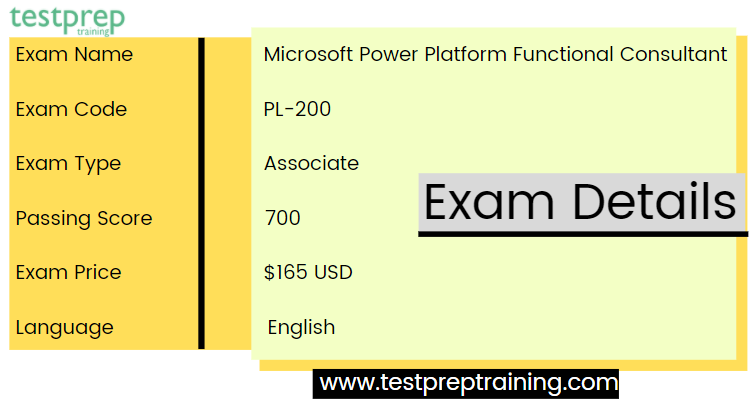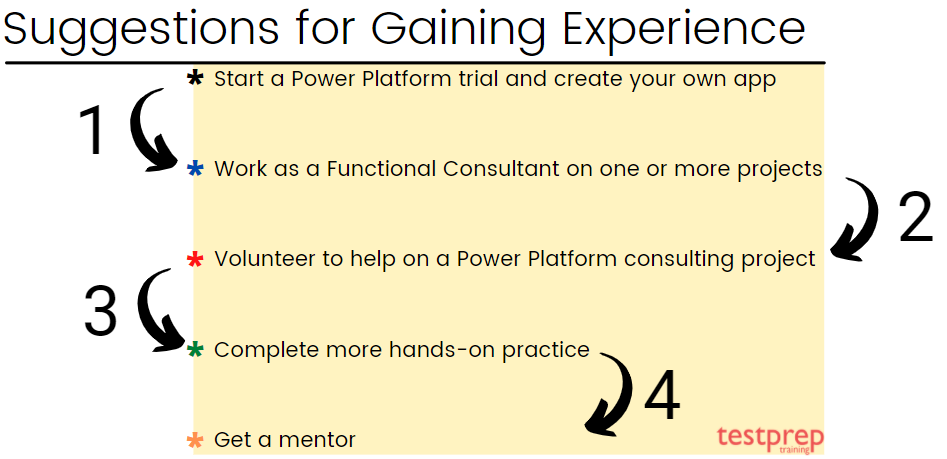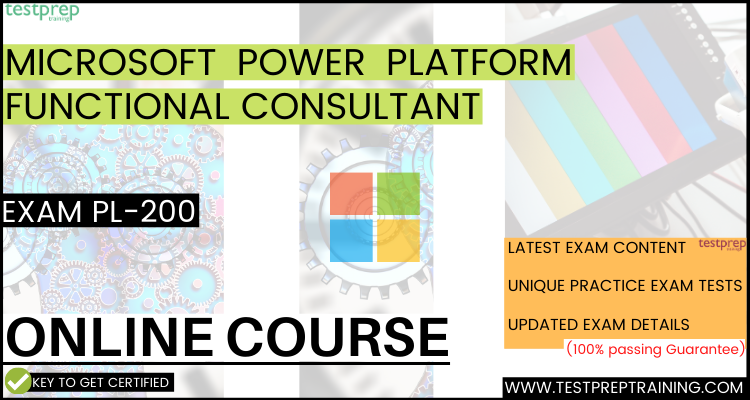The PL-200 exam is a certification exam for Microsoft Power Platform Functional Consultants. It tests the skills and knowledge required to design and configure solutions using the Power Platform components. The exam covers various topics, including data and entities, Power Apps, Power Automate, Power BI, Power Virtual Agents, Common Data Services, integrations, and best practices and governance. Passing the PL-200 exam demonstrates a candidate’s proficiency in using the Power Platform to solve business problems and provide solutions to clients.
However, to earn this certification, you have to pass Exam PL-200: Microsoft Power Platform Functional Consultant. This new exam standalone certification is a prerequisite for earning certifications in areas like Dynamics 365 Sales, Marketing, Customer Service, and Field Service. Also, this exam has replaced Exam MB-200: Microsoft Power Platform + Dynamics 365 Core.
The Microsoft Power Platform is a low-code platform that enables users to build business applications, automate workflows, and analyze data. It consists of four main components:
- Power Apps – Enables users to develop custom applications for web and mobile platforms without the need for coding.
- Power Automate – Enables users to create workflows and automate processes across various applications and services.
- Power BI – Provides data analytics and visualization tools for creating reports and dashboards.
- Power Virtual Agents – Allows users to create chatbots that can interact with users and automate responses.
But, this is not the end! In this article, we will talk about everything related to the PL-200 Exam including the modifications, exam details as well as its learning areas. So, let’s get started with it.
The Microsoft Exam MB-200 has expired on December 31, 2020 and was replaced by Exam PL-200 .
Microsoft Exam PL-200: Overview
The Microsoft Power Platform Functional Consultant (PL-200) exam is designed for individuals possessing the expertise to conduct discovery, capture requirements, engage with subject matter experts and stakeholders, and translate requirements. Additionally, they demonstrate the capability to configure Power Platform solutions and apps. Furthermore, they are proficient in creating application enhancements, custom user experiences, system integrations, including custom process automation, and custom visualizations.
Microsoft Exam Skills Validation
- Firstly, it is essential to possess the capability to implement the design provided in collaboration with a solution architect and adhere to the standards, branding, and artifacts established by User Experience Designers.
- Secondly, candidates in this role actively collaborate with quality assurance team members to ensure that solutions meet both functional and non-functional requirements. Furthermore, they play a key role in identifying, generating, and delivering artifacts for packaging and deployment to DevOps engineers.
- Lastly, individuals in this position also offer operations and maintenance training to Power Platform administrators.
However, those who have already performed these tasks, can take the exam and get certified to validate their skills. But, for others, it takes time to decide whether you’re ready to take the exam.
To understand if you have the required skills and knowledge, there are few questions that will help you get clarity including –
- Firstly, do you have knowledge for performing discovery, capturing requirements, engaging subject matter experts, and configuring Microsoft Power Platform solutions and apps?
- Secondly, do you know how to create application enhancements, custom user experiences, system integrations, and custom visualizations?
- Thirdly, do you have the skills to design seamless integrations with third-party applications and services?
- Lastly, do you have the ability to identify, generate, and deliver artifacts for packaging and deployment to DevOps engineers?
So, if you have the above skills and knowledge then, you can go for the PL-200 exam. To make it more clear, in the below section, we will talk about the knowledge and experience required for the PL-200 exam.
Microsoft PL-200 Exam: Knowledge Requirement
- Firstly, Power Platform Functional Consultants should be familiar with Dynamics 365 model-driven applications. They must have experience in using the Power Platform components for extending and customizing Dynamics 365 model-driven applications.
- Secondly, possessing knowledge of Microsoft Power Platform is crucial, including a practical understanding of its capabilities, boundaries, and constraints.
- Next, it is necessary to have experience using Microsoft Power Platform maker tools for creating solutions that use Microsoft Power Platform, Dynamics 365, and Microsoft 365.
Microsoft PL-200: Exam Details
For every certification exam, it is important to have all the necessary details that help you get a brief about the exam. That is to say, exam details help you to understand the exam procedure and pattern more accurately.

For Microsoft Power Platform Functional Consultant (PL-200) exam details include:
- Firstly, the Microsoft PL-200 exam is an associate-level exam. After passing the exam, you will become Microsoft Certified: Power Platform Functional Consultant Associate.
- Secondly, the Microsoft PL-200 passing score is 700 or more.
- Lastly, the PL-200 exam is available in the English language. And, the cost for the PL-200 exam is $165 USD along with the additional taxes.
Microsoft PL-200: Course Outline
We know that the PL-200 exam is a replacement for the MB-200 Exam. And, it is important to understand the major changes and modifications done in the exam. The best way is to go through the exam topics. Going through exam objectives will help you to learn and understand the difference more clearly. For the Microsoft Power Platform Functional Consultant (PL-200) exam, the topics include:
1. Configure Microsoft Dataverse (25-30%)
1.1 Manage a data model
- Create or modify standard, activity, or virtual tables
- create new tables or modify existing tables (Microsoft Documentation: Create a custom table, Editing Table)
- Determine which type of relationship to implement, including one-to-many and many-to-many (Microsoft Documentation: Table relationships, Create N:N (many-to-many) table relationships, Create one-to-many or many-to-one table relationships)
- configure table relationship including behaviors cascading rules (Microsoft Documentation: Configuring entity relationship cascading behavior, Table relationships)
- create new relationships or modify existing relationships (Microsoft Documentation: Create and edit One-to-many or Many-to-one table relationships, Create a relationship between tables)
- After that, create new columns or modify existing columns (Microsoft Documentation: Create and edit columns)
- configure table properties
1.2 Manage Dataverse
- Configure Dataverse search, and manage the search index
- After that, Managing auditing (Microsoft Documentation: Auditing, Configure entities and attributes for auditing)
- Describe options for importing and exporting data
- configure duplicate detection settings (Microsoft Documentation: Detect duplicate data, Enable and Disable duplicate detection, Set up duplicate detection)
- Configure bulk deletion
1.3 Configure security settings
- Firstly, Manage business units (Microsoft Documentation: Security concepts in Microsoft Dataverse, Create or edit business units)
- create and manage security roles (Microsoft Documentation: Create users and assign security roles, Security roles and privileges)
- After that, create and manage users and teams (Microsoft Documentation: Microsoft Dataverse for Teams environment, Create users and assign security roles)
- create and manage column security
- configure hierarchy security (Microsoft Documentation: Hierarchy security to control access)
- Configure Microsoft Entra ID group teams
2. Create apps by using Microsoft Power Apps (25-30%)
2.1 Create model-driven apps
- create and configure multiple forms types (Microsoft Documentation: Create and design model-driven app forms)
- Use controls in the form designer
- create and configure views (Microsoft Documentation: Create and edit public or system model-driven app views)
- Configure custom pages
- configure site maps and compose model-driven apps
- Configure modern commanding by using Power Fx
- Embed a canvas app in a model-driven app form
- Add Microsoft Power BI dashboards and reports in a model-driven app
2.2 Define canvas apps
- Describe canvas app structure
- Describe form navigation, formulas, variables and collections, and error handling (Microsoft Documentation: Back and Navigate functions in Power Apps, Understand variables in canvas apps, Errors function in Power Apps)
- Describe how Microsoft Power Automate flows are called from a canvas app
2.3 Build Microsoft Power Pages
- Configure pages, forms, and navigation (Microsoft Documentation: About basic forms, Manage web pages)
- Describe advanced Power Pages features, including document management, search, multi-step forms, and Power BI
- Configure website security including web roles and page access (Microsoft Documentation: Create web roles for portals)
- Describe use cases for templates (Microsoft Documentation: Use Word templates to create standardized documents)
- Describe authentication options
3. Create and manage logic and Process Automation (25-30%)
3.1 Create and manage cloud flows
- Firstly, describe types of flows, use cases and flow components including when to use a classic workflow (Microsoft Documentation: Different types of flows)
- Describe components of a connector
- Implement logic controls including branches, loops, conditions, error handling, and variables (Microsoft Documentation: Create loops that repeat workflow actions, Handle errors and exceptions in Azure Logic Apps)
- Implement dynamic content and expressions
- Work with the Dataverse connector
- Test and troubleshoot flows (Microsoft Documentation: Troubleshooting a cloud flow)
3.2 Create and manage business process flows
- configure a business process flow (Microsoft Documentation: Create a business process flow)
- Add stages, workflows, and action steps to a business process flow (Microsoft Documentation: Create a business process flow)
- Manage the business process flow table for a business process flow (Microsoft Documentation: Business process flows)
3.3 Create and manage classic Dataverse workflows
- Configure a workflow
- Troubleshoot workflows (Microsoft Documentation: Troubleshoot and diagnose workflow failures in Azure Logic Apps)
- Manage workflow logs
3.4 Implement low-code logic
- Configure low-code plug-ins
- Write and use Power Fx functions and formulas
- Create and configure business rules
4. Define an environment strategy (15–20%)
4.1 Participate in Application Lifecycle Management (ALM)
- Describe use cases for App Checker and Solution Checker (Microsoft Documentation: Use the solution checker to validate your model-driven apps in Power Apps)
- Create and manage solutions (Microsoft Documentation: Solutions overview)
- Describe the difference between managed and unmanaged solutions (Microsoft Documentation: Solution concepts)
- Manage Microsoft Power Platform environments for development
- Import and export Dataverse solutions
4.2 Describe interoperability with other services
- Configure email integration
- Configure Microsoft SharePoint integration
- Describe options for document management
- Work with Microsoft Word templates
Microsoft PL-200 Exam Learning Path
In order to help you understand and learn during the preparation for the Microsoft Power Platform Functional Consultant (PL-200) exam. Microsoft provides its PL-200 learning path that is categorized into modules containing all necessary information. For the Microsoft Power Platform Functional Consultant (PL-200) exam, this includes:
- Firstly, getting started using Dataverse.
- Secondly, managing permissions and administration for Dataverse
- Thirdly, creating a canvas app in PowerApps
- Fourthly, creating a model-driven application in Power Apps
- Then, creating a business process flow in Power Automate
- Next, automating business processes using Power Automate as well as using best practices to secure and govern Power Platform environments.
- After that, creating and using analytics reports with Power BI. And, creating relationships, business rules, calculations, and rollups in Dataverse.
- Lastly, creating bots with Power Virtual Agents and bringing AI to your business with AI Builder.

Microsoft Additional Learning Resources
Microsoft helps you find all the information about the exam and provide resources accordingly to help you have better preparation. Related to this, Microsoft provides two knowledge source that will help you throughout your journey to pass the PL-200 exam include:
- Microsoft Documentation
- Instructor-led Training
Where Microsoft Documentation helps you easily understand the concepts and modules related to the PL-200 exam. Further, it also allows you to navigate topics you want to learn about. And, on the other hand, Microsoft offers Power Platform Functional Consultant Associate Instructor-led training for the Microsoft PL-200 exam. Using this, you will learn to perform discovery, capture requirements, and configure Power Platform solutions and apps. Moreover, these hands-on labs and training will help you creating application enhancements, custom user experiences, data conversions, and custom process automation. Further, this course also covers four applications that are Microsoft Dataverse (Common Data Service), AI Builder, connectors, and portals.
Moving onto the next important part of this article which is the PL-200 exam Practice tests. To get perfection in all the concepts it is best to use practice tests and assess yourself. So, let’s take a look at it.
Evaluate yourself with Practice Tests: Microsoft PL-200 Exam
Practice tests are important for having better preparation. With these tests, you will be able to assess yourself as well as to know about your weak and strong areas. But, what’s important here is to get the best available Microsoft PL-200 practice tests. There are many PL-200 training sources out there where you can get the tests related to the Exam. But, to get the best practice tests, you have to do some research work. Related to this, you can take reference from sources like Testprep training which provide a detailed review of your performance, especially your strengths and your weak areas. With good learning, for Microsoft Power Platform Functional Consultant (PL-200) exam Testprep Training also provides you with:
- Firstly, they provide full-length mock exams with 150 unique questions.
- Secondly, there are objective-based questions based on the exam course outline.
- Thirdly, there is a detailed explanation for every question.
- Lastly, you will get lifetime access to the practice tests.
Expert’s Corner
The Microsoft Power Platform Functional Consultant certification is an important credential for professionals who work with the Power Platform. This certification demonstrates a candidate’s expertise in designing and configuring solutions using the Power Platform components. It is particularly useful for individuals who work in roles such as business analysts, solution architects, or functional consultants.
Preparing for the PL-200 exam requires a solid understanding of the Power Platform and its components, as well as hands-on experience in creating solutions using these tools. Candidates need to be acquainted with the exam format and the covered topics, and they should formulate a study plan that incorporates practice exams and a review of relevant documentation.
Attaining the Microsoft Power Platform Functional Consultant certification can unlock new career possibilities and support individuals in progressing within their current roles. Moreover, it serves as a testament to a candidate’s commitment to professional development and dedication to staying abreast of the latest industry trends and technologies.



